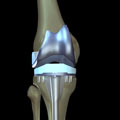Description of the procedure
In knee replacement, the damaged joint is removed and replaced with an artificial joint (called a prosthesis) that is made of metal, plastic, and polymers. Knee replacement surgery can help improve mobility and alleviate pain caused by damaged knee joints.
This procedure is usually performed by an orthopedic surgeon. The surgery is done under anesthesia in a hospital setting.
When should this procedure be performed?
Doctors perform this procedure as required. The new knee joint does not need adjustment unless there is a problem (e.g., failure of the joint, damage caused over time from normal use, joint infection). Most knee replacements last for a long time, although the amount of time depends on individual factors such as wear and tear on the joint.
Why is this procedure performed?
Replacing the knee joint reduces pain and improves the quality of life for many people living with damaged knee joints. This damage may be due to severe arthritis, injury from trauma or sports activities, or other causes.
Are there any risks and precautions?
Certain risks are common to all surgery and anesthesia. These risks depend on many factors including the type of surgery and your own medical condition. The possible, but very rare, side effects include: side effects of the anesthetic, breathing problems, infection, bleeding, scarring, and death.
Although knee replacement is generally considered safe, it does have some risks of side effects or complications. Infection of the incision or at the site of the replacement may occur. Contact your doctor immediately if you experience fever, pain, or swelling. Antibiotics normally clear up a bacterial infection, but other treatments may be necessary.
Blood clots may also form. These clots may form in the leg, causing inflammation of the blood vessels. They may also travel to the heart, brain, or lung and cause a heart attack, stroke, or pulmonary embolism. Speak to your doctor about your personal risk of blood clots and how to prevent these complications.
You may experience problems with the joint. The artificial joint may dislocate or break, or may become loose or stiff. Artificial joints used in knee replacement procedures may wear out over time. Speak with your doctor to find out how you can prolong the life of your new joint.
If the artificial joint no longer works, you may need another procedure to determine why it is no longer functioning properly.
If you are concerned about any symptoms following this procedure, speak to your doctor. Take the time to be sure you understand all the risks of complications and side effects as well as any precautions you or your doctor can take to avoid them. Be sure your doctor understands all your concerns.
What happens during the procedure?
- You are given anesthesia.
- Then the surgeon puts your knee in a bent position and makes an incision to expose the joint.
- The knee joint is removed along with any damaged bone or cartilage before the new artificial joint is inserted and adjusted for positioning.
- The surgeon will then close the incision and send you to a recovery room.
The procedure usually lasts about 2 hours.
How should I prepare for this procedure?
Before having this procedure, discuss the advantages, disadvantages, long-term risks, and consequences associated with the procedure with your doctor. Be sure you fully understand what will happen and are comfortable with your doctor's answers to your questions.
Your complete medical history is documented and an examination of the joint takes place before the procedure. The doctor performing the procedure may also request other tests to understand how your joint is performing. Bone density tests or magnetic resonance imaging (MRI) may help assess the joint.
Do not eat for 8 hours before the procedure. You may be able to continue to drink clear liquids until 2 hours before the procedure. If your doctor has recommended different times, follow the timing recommended by your doctor.
Tell your doctor or prescriber about all prescription, over-the-counter (non-prescription), and herbal medications that you are taking. Also tell them about any medication allergies and medical conditions that you may have.
Ask your doctor or pharmacist whether you need to stop taking any of your medications before the procedure.
To make your living space comfortable after you return home, think about making changes to it before your surgery. If you have stairs in your home, consider avoiding them by moving items you need on a regular basis to a lower floor. It may be wise to plan most of your daily activities for a floor with a washroom.
Arrange for someone to drive you home from the hospital and have someone help with your daily activities for the first few weeks.
What can I expect after the procedure?
After surgery, you will be awakened in the recovery room. At this time, you will likely feel groggy, sore, and possibly nauseated. Nurses will be available if you need help. It is normal to spend 3 to 5 days in the hospital after the procedure. You need this time to recover and doctors use this time to monitor your progress before sending you home. Before you go home, the doctor or nurse will go over what you need to do at home to complete your recovery. A physical therapist may also show you how to move and exercise your new knee.
Most people experience pain and swelling. Pain medication can help control the discomfort. As you begin to recover, you will be encouraged to move around to keep the new joint from becoming stiff and to prevent blood clots from forming. You may also be given medication to help prevent blood clots.
Moving around will be difficult after the procedure until the new joint heals. You may need crutches to get about. Slowly, you will begin to resume walking. At the same time, you will need to do physiotherapy and exercises to strengthen the knee. Your doctor or physiotherapist will also advise you about which movements are safe for you and which you should avoid.
The length of the recovery period varies from person to person. In general, it takes 3 to 6 weeks before you can return to your normal daily activities. Some people need longer to recover than others. Ask your doctor when it will be safe for you to resume your usual activities.
Results
Knee replacement surgery can help relieve pain, improve mobility, and increase the quality of life for people with certain knee problems.
All material copyright MediResource Inc. 1996 – 2024. Terms and conditions of use. The contents herein are for informational purposes only. Always seek the advice of your physician or other qualified health provider with any questions you may have regarding a medical condition. Source: www.medbroadcast.com/procedure/getprocedure/Knee-Replacement


